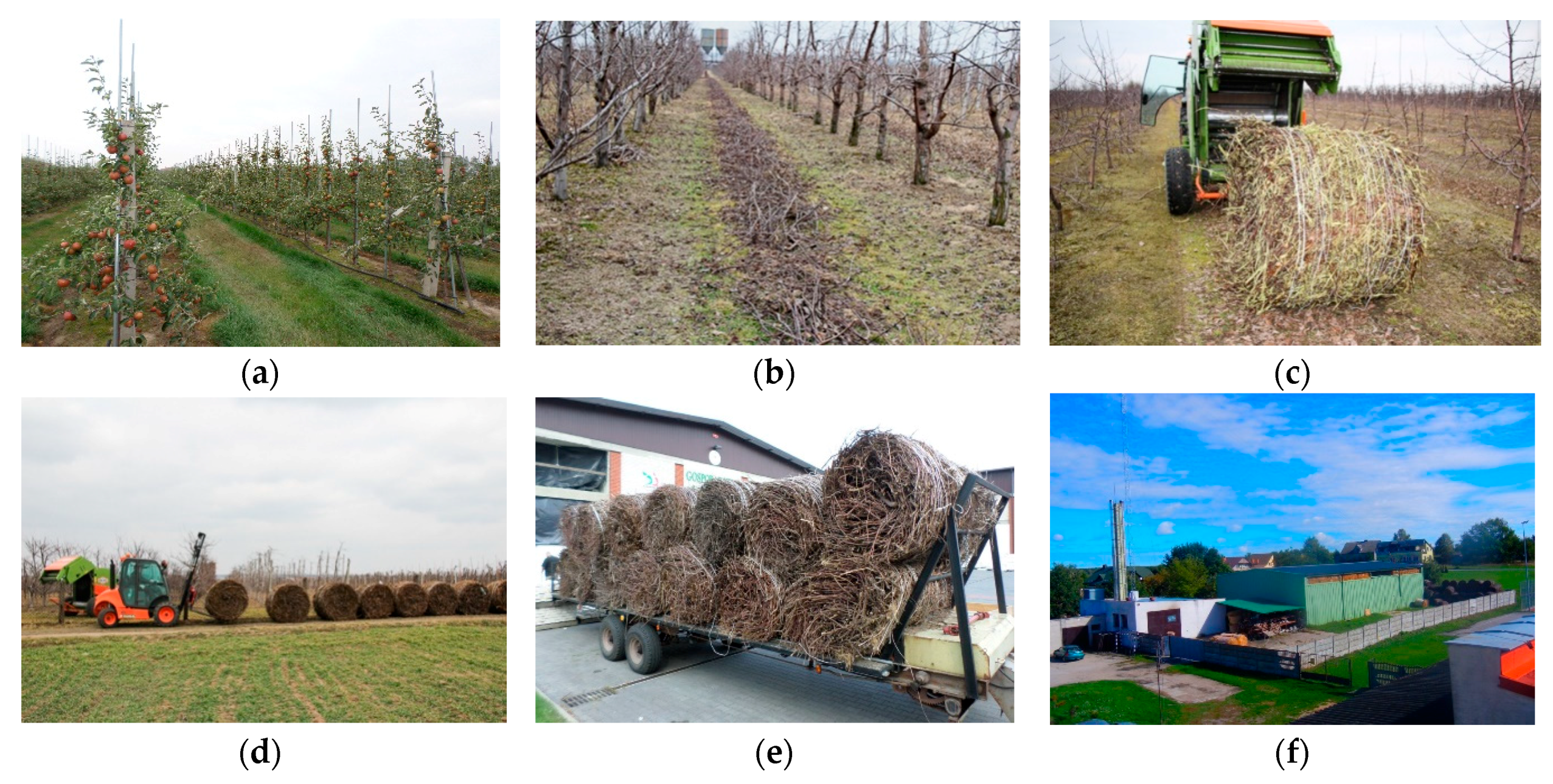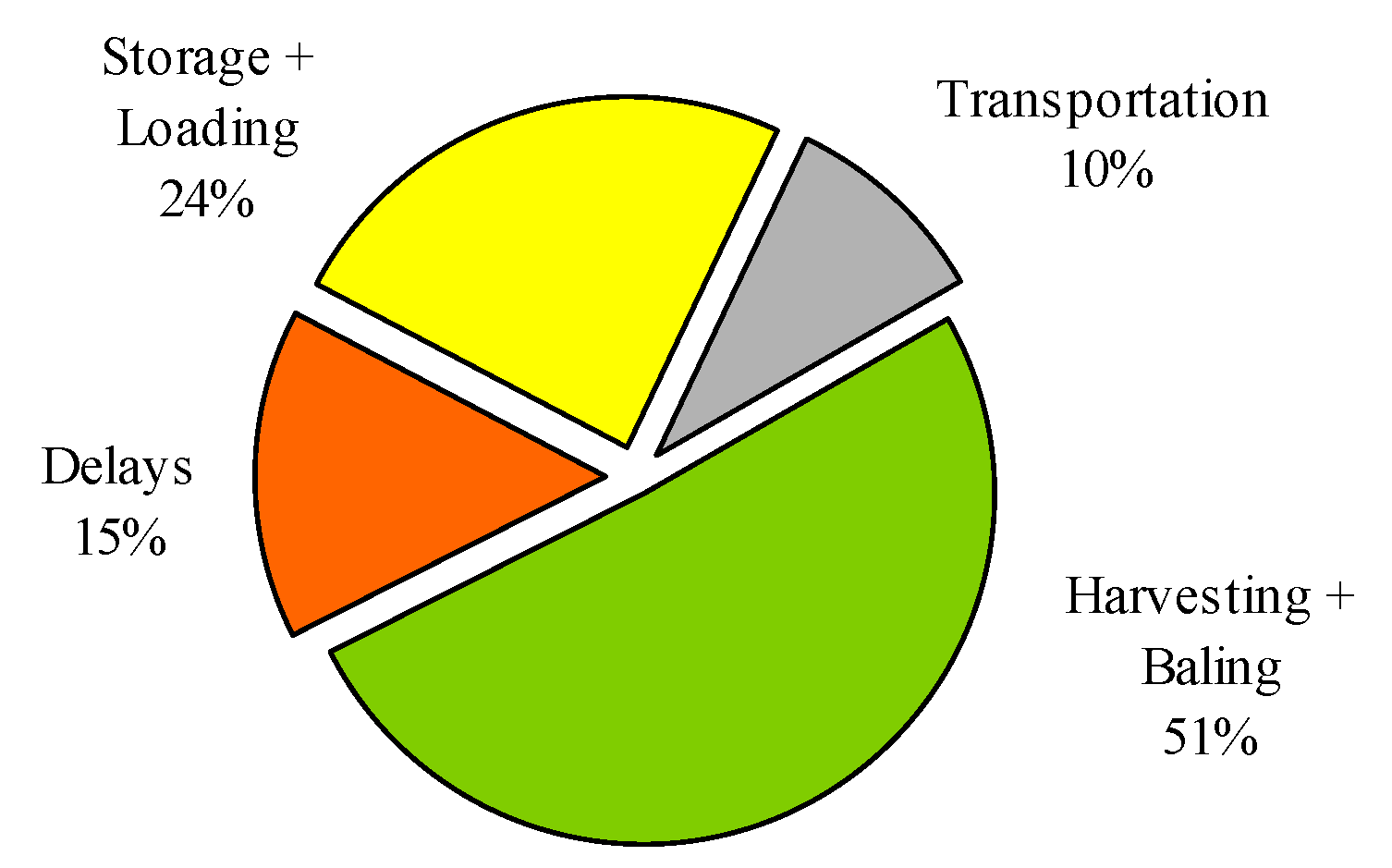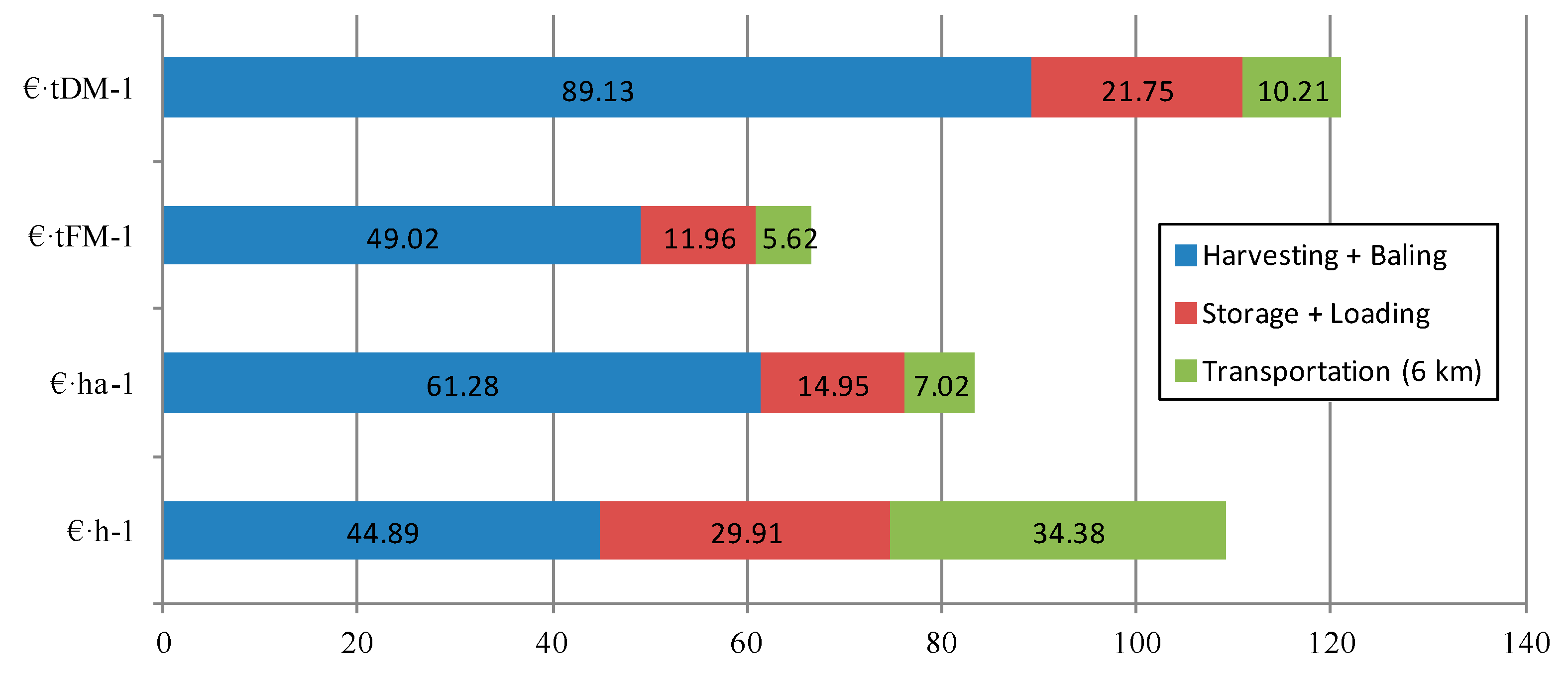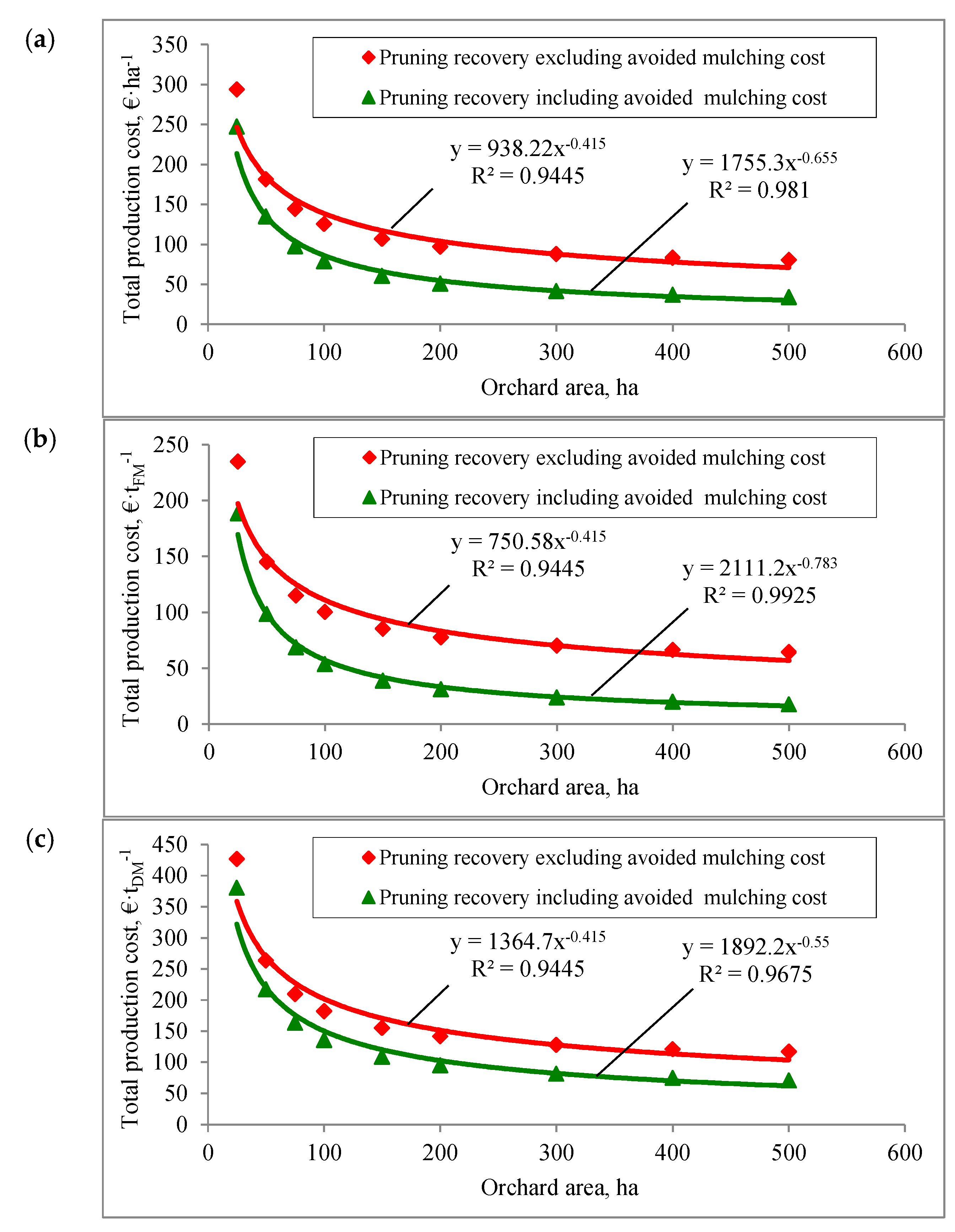Harvesting and Baling of Pruned Biomass in Apple Orchards for Energy Production
Abstract
1. Introduction
2. Materials and Methods
2.1. Study Site
2.2. Experimental Design and Data Collection
2.3. Working Time, Productivity, and Pruning Potential
2.4. Pruned Biomass Quality
2.5. Cost Analysis
2.6. Energy Analysis
3. Results
3.1. Harvested Biomass Analysis
3.2. Working Time and Productivity
3.3. Energy Analysis
3.4. Cost Analysis
4. Discussion
5. Conclusions
Author Contributions
Acknowledgments
Conflicts of Interest
Abbreviations
| A | ash content |
| DM | dry mass |
| EB | energy balance |
| EI | energy intensity |
| EIF | energy input flow |
| EIS | energy input share |
| EOF | energy output flow |
| EP | energy productivity |
| EROI | energy return on investment |
| FM | fresh mass |
| HHV | higher heating value |
| LHV | lower heating value |
| MC | moisture content |
| O&M | operation and maintenance |
| PtE | pruning to energy |
| PBP | pruning biomass potential |
| SMH | scheduled machine hours |
| WtE | waste to energy |
References
- European Union. Directive 2009/28/EC of the European Parliament and of the Council of 23 April 2009 on the Promotion of the Use of Energy from Renewable Sources; European Union: Brussels, Belgium, 2009. [Google Scholar]
- European Commision. New Commission Proposal to Minimize the Climate Impacts of Biofuel Production; European Commision: Brussels, Belgium, 2012. [Google Scholar]
- Psomopoulos, C.S.; Chatziaras, N.; Ioannidis, G.C.; Karaisas, P. The role of the new Commission’s proposal to minimize the climate impacts of biofuel production in energy and transport sectors. Fresenius Environ. Bull. 2014, 23, 2687–2694. [Google Scholar]
- Pari, L.; Suardi, A.; Longo, L.; Carnevale, M.; Gallucci, F.; Jatropha, L. Pruning Residues for Energy: Characteristics of an Untapped By-Product. Energies 2018, 11, 1622. [Google Scholar] [CrossRef]
- Neri, E.; Cespi, D.; Setti, L.; Gombi, E.; Bernardi, E.; Vassura, I.; Passarini, F. Biomass Residues to Renewable Energy: A Life Cycle Perspective Applied at a Local Scale. Energies 2016, 9, 922. [Google Scholar] [CrossRef]
- Nhuchhen, D.R.; Salam, P.A. Estimation of higher heating value of biomass from proximate analysis: A new approach. Fuel 2012, 99, 55–63. [Google Scholar] [CrossRef]
- Garcia, R.; Pizarro, C.; Lavin, A.G.; Bueno, J.L. Spanish biofuels heating value estimation. Part II: Proximate analysis data. Fuel 2014, 117, 1139–1147. [Google Scholar] [CrossRef]
- Maj, G. Emission Factors and Energy Properties of Agro and Forest Biomass in Aspect of 387 Sustainability of Energy Sector. Energies 2018, 11, 1516. [Google Scholar] [CrossRef]
- IEA. Energy and Climate Change; World Energy Outlook Special Report; IEA: Paris, France, 2015. [Google Scholar]
- EUROSTAT. Sustainable Development in the European Union. 2015 Monitoring Report of the EU Sustainable Development Strategy; Publications Office of the European Union: Luxembourg, 2015; Available online: http://ec.europa.eu/eurostat/documents/3217494/6975281/KS-GT-15-001-EN-N.pdf (accessed on 20 February 2018).
- Pari, L.; Alfano, V.; Garcia-Galindo, D.; Suardi, A.; Santangelo, E. Pruning Biomass Potential in Italy Related to Crop Characteristics, Agricultural Practices and Agro-Climatic Conditions. Energies 2018, 11, 1365. [Google Scholar] [CrossRef]
- Moulogianni, C.; Bournaris, T. Biomass Production from Crops Residues: Ranking of Agro-Energy Regions. Energies 2017, 10, 1061. [Google Scholar] [CrossRef]
- García-Galindo, D.; Cay Villa-Ceballos, D.F.; Vila-Villarroel, L.; Pueyo, E.; Sebastian, F. Seeking for ratios and correlations from field data for improving biomass assessments for agricultural pruning in Europe method and results. In Proceedings of the 24th European Biomass Conference and Exhibition, Amsterdam, The Netherlands, 6–9 June 2016; pp. 214–232. [Google Scholar] [CrossRef]
- EUROSTAT. Regional Statistics by NUTs Classification of Eurostat. Data on Regional Agriculture Statistics. “Structure of Agricultural Holdings” Dataset. Data for Year 2010; EUROSTAT: Luxembourg, 2016; Available online: http://ec.europa.eu/eurostat/web/regions/data/database (accessed on 20 February 2018).
- Dyjakon, A.; Mudryk, K. Energetic Potential of Apple Orchards in Europe in Terms of Mechanized Harvesting of Pruning Residues. In Renewable Energy Sources: Engineering, Technology, Innovation; Mudryk, K., Werle, S., Eds.; Springer: Cham, Switzerland, 2018; pp. 593–602. [Google Scholar]
- Picchi, G.; Silvestri, S.; Cristoforetti, A. Vineyard residues as a fuel for domestic boilers in Trento Province (Italy): Comparison to wood chips and means of polluting emissions control. Fuel 2013, 113, 43–49. [Google Scholar] [CrossRef]
- Carus, M. Biobased Economy and Climate Change—Important Links, Pitfalls, and Opportunities. Ind. Biotechnol. 2017, 13, 41–51. [Google Scholar] [CrossRef]
- García-Galindo, D.; Gomez-Palmero, M.; Pueyo, E.; Germer, S.; Pari, L.; Afano, V.; Dyjakon, A.; Sagarna, J.; Rivera, S.; Poutrin, C. Agricultural pruning as biomass resource: Generation, potentials and current fates. An approach to its state in Europe. In Proceedings of the 24th European Biomass Conference and Exhibition, Amsterdam, The Netherlands, 6–9 June 2016; pp. 1579–1595. [Google Scholar] [CrossRef]
- Frąckowiak, P.; Adamczyk, F.; Wąchalski, G.; Szaroleta, M.; Dyjakon, A.; Pari, L.; Suardi, A. A prototype machine for harvesting and baling of pruning residues in orchards: First test on apple orchard (MALUS MILL.) in Poland. J. Res. Appl. Agric. Eng. 2016, 61, 88–93. [Google Scholar]
- Spinelli, R.; Magagnotti, N.; Nati, C. Harvesting vineyard pruning residues for energy use. Biosyst. Eng. 2010, 105, 316–322. [Google Scholar] [CrossRef]
- Bosona, T.; Gebresenbet, G.; Garcia, D. Logistics Performances of Agricultural Prunings’ Supply Chain. In Proceedings of the 24th European Biomass Conference and Exhibition, EUBCE 2016: 1BV.4.64, Amsterdam, The Netherlands, 6–9 June 2016. [Google Scholar]
- Magagnotti, N.; Pari, L.; Picchi, G.; Spinelli, R. Technology alternatives for tapping the pruning residue resource. Bioresour. Technol. 2013, 128, 697–702. [Google Scholar] [CrossRef] [PubMed]
- Rentizelas, A.A.; Tolis, A.J.; Tatsiopoulos, I.P. Logistics issues of biomass: The storage problem and the multi-biomass supply chain. Renew. Sustain. Energy Rev. 2009, 13, 887–894. [Google Scholar] [CrossRef]
- Alfonso, D.; Perpina, C.; Perez-Navarro, A.; Penalvo, E.; Vargas, C.; Cardenas, R. Methodology for optimization of distributed biomass resources evaluation, management and final energy use. Biomass Bioenergy 2009, 33, 1070–1079. [Google Scholar] [CrossRef]
- Ruiz, J.A.; Juarez, M.C.; Morales, M.P.; Munoz, P.; Mendivil, M.A. Biomass logistics: Financial & environmental costs. Case study: 2 MW electrical power plants. Biomass Bioenergy 2013, 56, 260–267. [Google Scholar]
- Asztemborski, B.; Wnuk, R. Poland’s Promising Market Segments for Heating with Solid Biomass (>100 kW); Report. Horizon 2020 Coordination and Support Action number 646495: Bioenergy for Business, Uptake of Solid Bioenergy in European Commercial Sectors; The Polish National Energy Conservation Agency (KAPE): Warsaw, Poland, 2015. [Google Scholar]
- Velazquez-Marti, B.; Fernandez-Gonzales, E.; Callejon-Ferre, A.J.; Estornell-Cremades, J. Mechanized methods for harvesting residual biomass from Mediterranean fruit tree cultivations. Sci. Agricola 2012, 69, 180–188. [Google Scholar] [CrossRef]
- Spinelli, R.; Nati, C.; Pari, L.; Mescalchin, E.; Magagnotti, N. Production and quality of biomass fuels from mechanized collection and processing of vineyard pruning residues. Appl. Energy 2012, 89, 374–379. [Google Scholar] [CrossRef]
- Spinelli, R.; Picchi, G. Industrial harvesting of olive tree pruning residue for energy biomass. Bioresour. Technol. 2010, 101, 730–735. [Google Scholar] [CrossRef] [PubMed]
- GUS (Central Statistical Office). Production of Agricultural And horticultural Crops in 2016; Department of Agriculture: Warsaw, Poland, 2017; ISSN 1507-9678. [Google Scholar]
- Spinelli, R.; Visser, R. Analyzing and estimating delays in harvester operations. Int. J. For. Eng. 2008, 19, 36–41. [Google Scholar]
- ISO 18134-2. Solid Biofuels—Determination of Moisture Content—Oven Dry Method—Part 2: Total Moisture—Simplified Method; European Committee for Standardization: Brussels, Belgium, 2017. [Google Scholar]
- PN-EN 14775. Solid Biofuels—Determination of Ash Content; European Committee for Standardization: Brussels, Belgium, 2010. [Google Scholar]
- PN-EN 14918. Solid Biofuels—Determination of Calorific Value; European Committee for Standardization: Brussels, Belgium, 2010. [Google Scholar]
- FAO. Wood Fuels Handbook; FAO: Rome, Italy, 2013; Available online: http://dx.doi.org/10.1017/CBO9781107415324.004 (accessed on 25 April 2018).
- Miyata, E.S. Determining fixed and operating costs of logging equipment. In General Technical Report NC-55; Forest Service North Central Forest Experiment Station: St. Paul, MN, USA, 1980; p. 14. [Google Scholar]
- Schulter, R.T.; Frank, G.G. Estimating Agricultural Field Machinery Costs; University of Wisconsin-Extension, Agricultural Bulletin A3510, Report I-03-91-3M-65-E; University of Wisconsin-Extension: Madison, WI, USA, 2015. [Google Scholar]
- Edwards, W. Estimating Farm Machinery Costs; Ag Decision Maker. Iowa State University, File A3-29, PM 710; Iowa State University: Ames, IA, USA, 2015. [Google Scholar]
- EUROSTAT. Labour Costs Annual Data—NACE Rev. 2; EUROSTAT: Luxembourg, 2016. [Google Scholar]
- Nati, C.; Boschiero, M.; Picchi, G.; Mastrolonardo, G.; Kelderer, M.; Zerbe, S. Energy performance of a new biomass harvester for recovery of orchard wood wastes as alternative to mulching. Renew. Energy 2018, 124, 121–128. [Google Scholar] [CrossRef]
- IFIAS. Energy Analysis; Workshop Report No. 6; IFIAS: Stockholm, Sweden, 1974; p. 89. [Google Scholar]
- PIPP (Polish Chamber of Liquid Fuels). Report from 13 April 2018. Available online: http://www.paliwa.pl/strona-startowa/aktualnosci (accessed on 11 May 2018).
- Bailey, A.P.; Basford, W.D.; Penlington, N.; Park, J.R.; Keatinge, J.D.; Rehman, T.; Tranter, R.B.; Yates, C.M. A comparison of energy use in conventional and integrated arable farming in the UK. Agric. Ecosyst. Environ. 2003, 97, 241–253. [Google Scholar] [CrossRef]
- Jarach, M. On equivalence values for analysis and balance energy in agriculture. Riv. Ing. Agr. 1985, 2, 102–114. [Google Scholar]
- Picchio, R.; Maesano, M.; Savelli, S.; Marchi, E. Productivity and energy balance in conversion of Quercus cerris L. Coppice Stand into High Forest in Central Italy. Croat. J. For. Eng. 2009, 30, 15–26. [Google Scholar]
- Spinelli, R.; Magagnotti, N. The effects of introducing modern technology on the financial, labour and energy performance of forest operations in the Italian Alps. For. Policy Econ. 2011, 13, 520–524. [Google Scholar] [CrossRef]
- Manzone, M.; Spinelli, R. Efficiency of small-scale firewood processing operations in Southern Europe. Fuel Process. Technol. 2014, 122, 58–63. [Google Scholar] [CrossRef]
- Fluck, R. Energy sequestered in repairs and maintenance of agricultural machinery. Trans. ASAE 1985, 28, 738–744. [Google Scholar] [CrossRef]
- Veiga, J.P.S.; Romanelli, T.L.; Gimenez, L.M.; Busato, P.; Milan, M. Energy embodiment in Brazilian agriculture: An overview of 23 crops. Sci. Agric. 2015, 72, 471–477. [Google Scholar] [CrossRef]
- Velazquez-Marti, B.; Fernandez-Gonzales, E.; Lopez-Cortes, I.; Salazar-Hernandez, D.M. Quantification of the residual biomass obtained from pruning of vineyards in Mediterranean area. Biomass Bioenergy 2011, 35, 3453–3464. [Google Scholar] [CrossRef]
- Manzone, M.; Gioelli, F.; Balsari, P. Kiwi clear-cut: First evaluation of recovered biomass for energy production. Energies 2017, 10, 1837. [Google Scholar] [CrossRef]
- Perea-Moreno, A.-J.; Perea-Moreno, M.-A.; Pilar Dorado, M.; Manzano-Agugliaro, F. Mango stone properties as biofuel and its potential for reducing CO2 emissions. J. Clean. Prod. 2018, 190, 53–62. [Google Scholar] [CrossRef]
- KOBiZE (The National Centre for Emissions Management). Calorific Values and CO2 Emission Factors in 2015 for Reporting within Emission Trading System (ETS) for 2018; KOBiZE: Warsaw, Poland, 2017. [Google Scholar]
- Dyjakon, A.; Den Boer, J.; Bukowski, P.; Adamczyk, F.; Frąckowiak, P. Wooden biomass potential from apple orchards in Poland. Wood 2016, 59, 73–86. [Google Scholar]
- Spinelli, R.; Magagnotti, N.; Nati, C.; Cantini, C.; Sani, G.; Picchi, G.; Biocca, M. Integrating olive grove maintenance and energy biomass recovery with a single-pass pruning and harvesting machine. Biomass Bioenergy 2011, 35, 808–813. [Google Scholar] [CrossRef]





| Feature | Biomass Baler | Feature | Tractor |
|---|---|---|---|
| Model | Wolagri R98 | Model | KUBOTA M7040DHC |
| Bale diameter, cm | 120 | Engine | V3307-DI (4 cyl.) |
| Bale width, cm | 98 | Net Power, HP/kW | 68/50.7 |
| Pick-up width, cm | 130 or 190 disc end | Total displacement, cc | 3331 |
| Pressing chamber | fixed 32 crossbars | Max. travel speed, km∙h−1 | 31 |
| PTO shaft | homokinetic | PTO power, HP/kW | 62/46.3 |
| Tires supplied as standard | 11.5/80–15 | PTO type | Live-independent, hydraulic |
| Lubrication | optional | Tire size front/rear | 9.5 × 24/16.9 × 30 |
| Swivelling eyebolt Ø35 | standard | Overall length, mm | 3445 |
| Road signaling kit | standard | Overall height, mm | 2545 |
| Road homologation | standard | Overall width, mm | 1860 |
| Required power (kW/HP) | 38/50 | Turning radius, m | 3.6 |
| Transport width, m | 1.71 | Lift capacity, kg | 1500 |
| Weight, kg | 1940 | Tractor weight, kg | 2440 |
| Operation/Action | Recovery | Mulching | ||||||
|---|---|---|---|---|---|---|---|---|
| Harvesting + Baling | Storage + Loading | Transportation | Mulching | |||||
| Machine | Carrier | Attachment | Carrier | Carrier | Attachment | Carrier | Attachment | |
| Tractor | Baler | Forklift | Tractor | Trailer | Tractor | Mulcher | ||
| KUBOTA M7040DHC | Wolagri R98 | AUSA C150H | KUBOTA M7040DHC | No Data | KUBOTA M7040DHC | HUMUS KM 230 | ||
| Investment | € | 30,000 | 28,500 | 15,000 | 30,000 | 1 500 | 30,000 | 10,000 |
| Power | kW | 50.7 | 0 | 22.7 | 50.7 | 0 | 50.7 | 0 |
| Service life | years | 10 | 10 | 10 | 10 | 10 | 10 | 10 |
| Crew | no. | 1 | 0 | 1 | 1 | 0 | 1 | 0 |
| Labour cost | €∙h−1 | 19 | 0 | 19 | 19 | 0 | 19 | 0 |
| Usage | h∙year−1 | 1500 | 550 | 1000 | 1500 | 1000 | 1500 | 500 |
| Fixed cost | €∙h−1 | 2.4 | 6.0 | 1.7 | 2.4 | 0.2 | 2.4 | 2.4 |
| Variable cost | €∙h−1 | 26.00 | 3.06 | 23.18 | 26.00 | 0.08 | 26.00 | 1.29 |
| Overheads at 20% | €∙h−1 | 5.68 | 1.80 | 4.98 | 5.68 | 0.05 | 5.68 | 0.73 |
| Total cost | €∙h−1 | 34.08 | 10.81 | 29.91 | 34.08 | 0.30 | 34.08 | 4.37 |
| Equipment (Role) | Fossil Product | Fuel Consumption | Energetic Value | Energy | Mass | Energetic Value | Total EV | Service Life | Operation Time | Energy |
|---|---|---|---|---|---|---|---|---|---|---|
| - | kg | MJ∙kg−1 | MJ | kg | MJ∙kg−1 | MJ | h | h | MJ | |
| PtE Direct Input | PtE Indirect Input | |||||||||
| Tractor (harvesting) | Diesel | 2076.2 | 51.5 | 106,922 | 2440 | 92 | 224,480 | 15,000 | 546 | 8171 |
| Lubricant | 41.5 | 83.7 | 3476 | - | - | - | - | - | - | |
| Baler (harvesting) | Diesel | 0 | 51.5 | 0 | 1940 | 69 | 133,860 | 5500 | 546 | 13,289 |
| Lubricant | 41.5 | 83.7 | 3476 | - | - | - | - | - | - | |
| Forklift (storage-loading) | Diesel | 388.7 | 51.5 | 20,018 | 2600 | 92 | 339,200 | 10,000 | 200 | 4784 |
| Lubricant | 15.2 | 83.7 | 1273 | - | - | - | - | - | - | |
| Tractor (transport) | Diesel | 101.4 | 51.5 | 5222 | 2440 | 92 | 224,480 | 15,000 | 80 | 1197 |
| Lubricant | 22.5 | 83.7 | 1886 | - | - | - | - | - | - | |
| Trailer (transport) | Diesel | 0 | 51.5 | 0 | 2120 | 69 | 146,280 | 10,000 | 280 | 4096 |
| Lubricant | 0 | 83.7 | 0 | - | - | - | - | - | - | |
| Total | 142,273 | 31,537 | ||||||||
| Mulching Direct Input | Mulching Indirect Input | |||||||||
| Tractor (mulching) | Diesel | 1836.6 | 51.5 | 94,585 | 2440 | 92 | 224,480 | 15,000 | 483 | 7228 |
| Lubricant | 36.7 | 83.7 | 3074 | - | - | - | - | - | - | |
| Mulcher (shredding) | Diesel | 0 | 51.5 | 0 | 640 | 69 | 44,160 | 5000 | 483 | 4266 |
| Lubricant | 20.4 | 83.7 | 1708 | - | - | - | - | - | - | |
| Total | 99,368 | 11,494 | ||||||||
| Energetic Balance (PtE) | Energetic Balance (Mulching) | ||||||
|---|---|---|---|---|---|---|---|
| Input | MJ∙ha−1 | Input | MJ∙tDM−1 | Input | MJ∙ha−1 | Input | MJ∙tDM−1 |
| Direct | 355.7 | Direct | 517.4 | Direct | 248.4 | Direct | - |
| Indirect | 82.1 | Indirect | 119.4 | Indirect | 28.7 | Indirect | - |
| Total | 437.7 | Total | 636.7 | Total | 277.2 | Total | - |
| Output | 12,375 | Output | 18,000 | Output | 0 | Output | - |
| Balance | 11,937.3 | Balance | 17,363.3 | Balance | −277.2 | Balance | - |
| Indices | Value | Unit | |
|---|---|---|---|
| Energy balance (Net energy) | EB | 11,937 | MJ∙ha−1 |
| Energy return on investment (Energy ratio) | EROI | 28.27 | - |
| Energy input share | EIS | 3.54 | % |
| Energy productivity | EP | 2.86 | kgFM∙MJ−1 |
| 1.57 | kgDM∙MJ−1 | ||
| Energy Intensity | EI | 350 | MJ∙tFM−1 |
| 637 | MJ∙tDM−1 | ||
© 2018 by the author. Licensee MDPI, Basel, Switzerland. This article is an open access article distributed under the terms and conditions of the Creative Commons Attribution (CC BY) license (http://creativecommons.org/licenses/by/4.0/).
Share and Cite
Dyjakon, A. Harvesting and Baling of Pruned Biomass in Apple Orchards for Energy Production. Energies 2018, 11, 1680. https://doi.org/10.3390/en11071680
Dyjakon A. Harvesting and Baling of Pruned Biomass in Apple Orchards for Energy Production. Energies. 2018; 11(7):1680. https://doi.org/10.3390/en11071680
Chicago/Turabian StyleDyjakon, Arkadiusz. 2018. "Harvesting and Baling of Pruned Biomass in Apple Orchards for Energy Production" Energies 11, no. 7: 1680. https://doi.org/10.3390/en11071680
APA StyleDyjakon, A. (2018). Harvesting and Baling of Pruned Biomass in Apple Orchards for Energy Production. Energies, 11(7), 1680. https://doi.org/10.3390/en11071680




